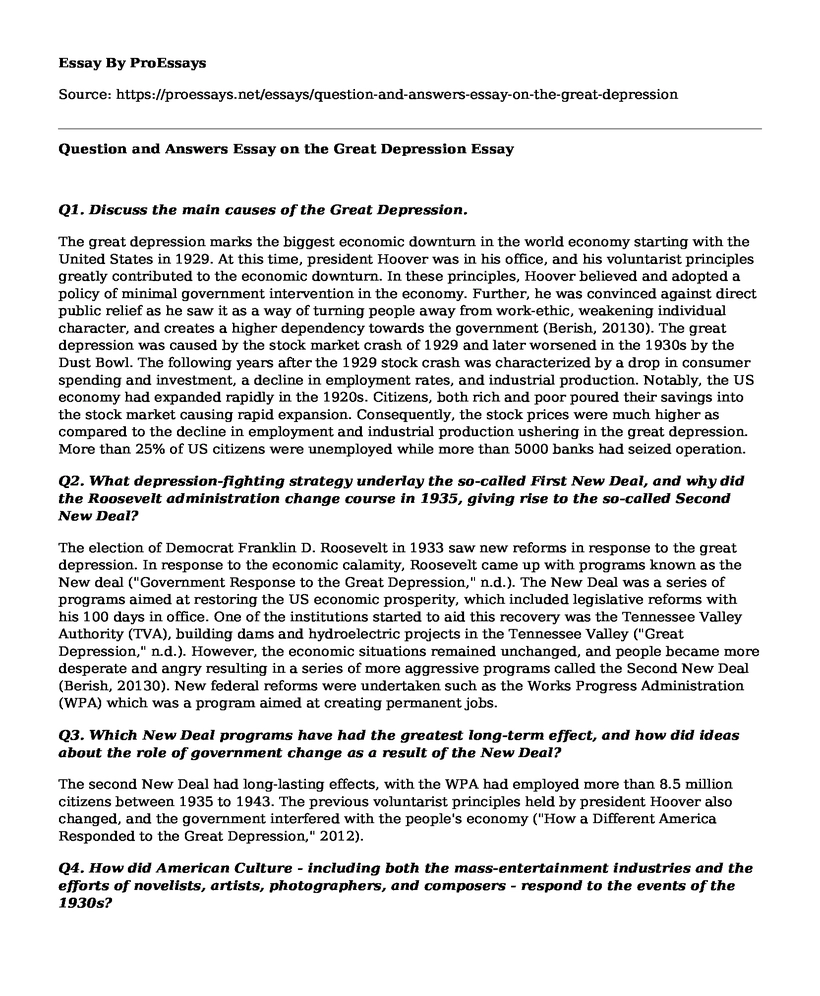Q1. Discuss the main causes of the Great Depression.
The great depression marks the biggest economic downturn in the world economy starting with the United States in 1929. At this time, president Hoover was in his office, and his voluntarist principles greatly contributed to the economic downturn. In these principles, Hoover believed and adopted a policy of minimal government intervention in the economy. Further, he was convinced against direct public relief as he saw it as a way of turning people away from work-ethic, weakening individual character, and creates a higher dependency towards the government (Berish, 20130). The great depression was caused by the stock market crash of 1929 and later worsened in the 1930s by the Dust Bowl. The following years after the 1929 stock crash was characterized by a drop in consumer spending and investment, a decline in employment rates, and industrial production. Notably, the US economy had expanded rapidly in the 1920s. Citizens, both rich and poor poured their savings into the stock market causing rapid expansion. Consequently, the stock prices were much higher as compared to the decline in employment and industrial production ushering in the great depression. More than 25% of US citizens were unemployed while more than 5000 banks had seized operation.
Q2. What depression-fighting strategy underlay the so-called First New Deal, and why did the Roosevelt administration change course in 1935, giving rise to the so-called Second New Deal?
The election of Democrat Franklin D. Roosevelt in 1933 saw new reforms in response to the great depression. In response to the economic calamity, Roosevelt came up with programs known as the New deal ("Government Response to the Great Depression," n.d.). The New Deal was a series of programs aimed at restoring the US economic prosperity, which included legislative reforms with his 100 days in office. One of the institutions started to aid this recovery was the Tennessee Valley Authority (TVA), building dams and hydroelectric projects in the Tennessee Valley ("Great Depression," n.d.). However, the economic situations remained unchanged, and people became more desperate and angry resulting in a series of more aggressive programs called the Second New Deal (Berish, 20130). New federal reforms were undertaken such as the Works Progress Administration (WPA) which was a program aimed at creating permanent jobs.
Q3. Which New Deal programs have had the greatest long-term effect, and how did ideas about the role of government change as a result of the New Deal?
The second New Deal had long-lasting effects, with the WPA had employed more than 8.5 million citizens between 1935 to 1943. The previous voluntarist principles held by president Hoover also changed, and the government interfered with the people's economy ("How a Different America Responded to the Great Depression," 2012).
Q4. How did American Culture - including both the mass-entertainment industries and the efforts of novelists, artists, photographers, and composers - respond to the events of the 1930s?
In the 1930s, the American popular culture was fraught with contradictions with the great depression. It was marked by experimentation by both the modernist and the traditionalist, marked with a simple longing of the past, such as the agrarian culture, and wonderful dreams of the future. A great interest among Americans grew in folk culture and tradition. Folk songs were collected by the library of congress resulting to great folk singers such as Pete Seeger and Woody Guthrie attracting a large fun base. Prominent intellectuals on the other hand saw the society as fragmented and marked by individualism ("Digital History: Popular Culture During the Great Depression," n.d.). As a result, a great push and campaign urging for the return of agrarian way of life arose through the efforts of the Southern Agrarians.
References
Berish, A. (2013). Great Depression, the. Oxford Music Online. doi:10.1093/gmo/9781561592630.article.a2241306
Digital History: Popular Culture During the Great Depression. (n.d.). Retrieved February 20, 2019, from http://www.digitalhistory.uh.edu/disp_textbook.cfm?smtid=2&psid=3452
Government Responses to the Great Depression. (n.d.). Retrieved from https://www.heritage.nf.ca/articles/politics/great-depression-government-response.php
The Great Depression. (n.d.). Retrieved from https://www.khanacademy.org/humanities/us-history/rise-to-world-power/great-depression/a/the-great-depression
How a Different America Responded to the Great Depression. (2012, November 19). Retrieved from http://www.pewresearch.org/2010/12/14/how-a-different-america-responded-to-the-great-depression/
Cite this page
Question and Answers Essay on the Great Depression. (2022, Nov 10). Retrieved from https://proessays.net/essays/question-and-answers-essay-on-the-great-depression
If you are the original author of this essay and no longer wish to have it published on the ProEssays website, please click below to request its removal:
- Essay Sample on War and Conflict in Syria
- Troy, Relationship Between Legend and Reality Essay
- Various Movements of the 1960s and U.S. Involvement in World War II
- Scientific Revolution, Decolonization, The Great Depression Paper Example
- Canada's Strategy During World War One - Essay Sample
- Essay Sample on Shirin Ebadi: Nobel Peace Prize Winner & Human Rights Pioneer
- Essay Sample on Michigan State: A Region of Achievements, Failure, and Calamity







